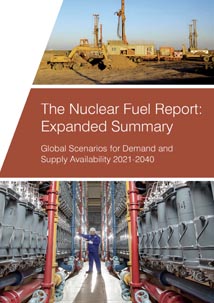The Nuclear Fuel Report Expanded Summary
World Nuclear Association has published reports on nuclear fuel supply and demand at roughly twoyearly intervals since its foundation in 1975. The 20th edition of the Nuclear Fuel Report was released in September 2021 and includes scenarios covering a range of possibilities for nuclear power to 2040. Forecasts of the years beyond 2040 are beyond the scope of this report and would require a rather different approach to capture the larger range of uncertainty; however, the key issues examined here are likely to have continued relevance during that longer period. This Expanded Summary covers the key findings of 20th edition, and explains the methodology and the assumption underlying the report’s three scenarios for future nuclear fuel demand and supply.
The full version of The Nuclear Fuel Report can be purchased from World Nuclear Association’s online shop.
Nuclear power currently contributes approximately 10% of the world’s electricity production. It is expected to play an increasingly important role in future electricity and energy supply for several reasons, including:
- The near-zero carbon dioxide and other pollutant emissions associated with nuclear power generation.
- The on-demand reliable and secure nature of nuclear power, attractive to developing countries, those lacking indigenous energy resources, and to developed countries intent on introducing high shares of renewables, while maintaining grid stability.
- Its long-term cost-competitiveness.
- The industrial and human-capital benefits associated with its development and use.
- The ability to produce near zero-carbon heat, in addition to electricity, that could help to decarbonize many hard-to-abate sectors of the economy.
Despite these advantages, nuclear energy faces several competitive challenges from other electricity generation sources, especially in deregulated markets as they are currently designed, along with continuing regulatory and political hurdles. Furthermore, electricity demand growth has slowed down, especially in the countries where nuclear power is well-established. At the same time, the nuclear sector remains strong in many developing countries, and it is in these countries that the majority of nuclear capacity growth is expected. China and India alone account for over half the projected new reactors.
